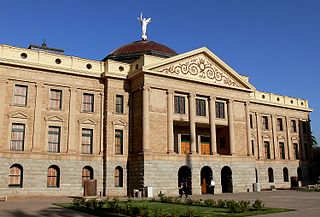
James Riely Gordon was an architect who practiced in San Antonio until 1902 and then in New York City, where he gained national recognition. J. Riely Gordon is best known for his landmark county courthouses, in particular those in Texas. Working during the state's "Golden Age" (1883–1898) of courthouse construction, Gordon saw 18 of his designs erected from 1885 to 1901; today, 12 remain.
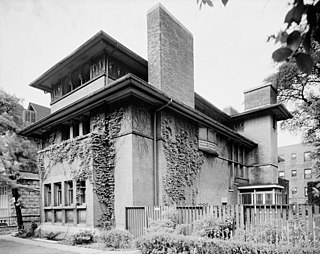
The Isidore H. Heller House is a house located at 5132 South Woodlawn Avenue in the Hyde Park community area of Chicago in Cook County, Illinois, United States. The house was designed by American architect Frank Lloyd Wright. The design is credited as one of the turning points in Wright's shift to geometric, Prairie School architecture, which is defined by horizontal lines, flat or hipped roofs with broad overhanging eaves, windows grouped in horizontal bands, and an integration with the landscape, which is meant to evoke native Prairie surroundings.

The Grover Cleveland Birthplace is a historic site located at 207 Bloomfield Avenue in Caldwell, Essex County, New Jersey, United States. It is the only house museum dedicated to U.S. President Grover Cleveland.

The Douglass House is a historic house currently located at the corner of Front and Montgomery Streets in the Mill Hill neighborhood of the city Trenton in Mercer County, New Jersey. It served as George Washington's headquarters prior to the Battle of Princeton on January 3, 1777. Listed as the Bright–Douglass House, it was documented by the Historic American Buildings Survey in 1936, when the house was located in Mahlon Stacy Park near the Delaware River. It was added to the National Register of Historic Places on December 18, 1970, for its significance in architecture, military and social history. It was added as a contributing property to the Mill Hill Historic District on December 12, 1977.
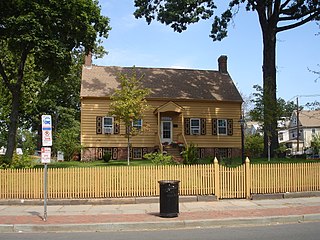
The Belcher–Ogden Mansion; Benjamin Price House; and Price–Brittan House Historic District is a 0.75-acre (3,000 m2) historic district located on East Jersey Street in Elizabeth, Union County, New Jersey, United States. It was added to the National Register of Historic Places on August 28, 1986, for its significance in architecture and exploration/settlement. It is located near Boxwood Hall and is in the heart of colonial Elizabethtown, the first English-speaking settlement in what became the Province of New Jersey.

The Fairview Schoolhouse is located east of Columbia in the Fairview Cemetery along Dean Road in Knowlton Township in Warren County, New Jersey, United States. It was built in 1835 and documented by the Historic American Buildings Survey (HABS) in 1937. The schoolhouse was added to the National Register of Historic Places on August 12, 1977, for its significance in architecture and education. It is now used by the Fairview Cemetery Association.
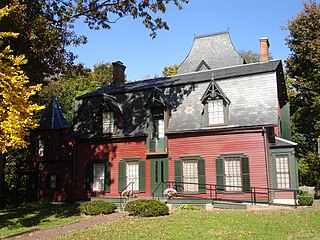
The Nathaniel Drake House is located at 602 West Front Street in the city of Plainfield in Union County, New Jersey. The house was built in 1746 and was added to the National Register of Historic Places on June 19, 1973, for its significance in architecture. It now operated as the Drake House Museum and is the headquarters of the Historical Society of Plainfield, though the building is owned by the City of Plainfield. The most famous piece in the Society's collection is the painting, "The Death of General Sedgwick" by Julian Scott.

Boisaubin Manor is a historic brick house located on Treadwell Avenue in the Convent Station section of Chatham Township, southeast of Morristown, in Morris County, New Jersey, United States. Built sometime between 1822 and 1834, it was added to the National Register of Historic Places on October 22, 1976, for its significance in art and architecture.

The Lambertville House is a historic building located at 32 Bridge Street in the city of Lambertville in Hunterdon County, New Jersey, United States. The stone section was built in 1812 by Captain John Lambert. It was added to the National Register of Historic Places on September 6, 1978, for its significance in architecture, commerce, and communications. It was listed as a contributing property of the Lambertville Historic District on June 30, 1983. Today, it is a hotel with restaurant and business meeting rooms.

Wood Lawn is a historic mansion located off Ryders Lane on the Douglass Campus of Rutgers University in the city of New Brunswick in Middlesex County, New Jersey. The house was added to the National Register of Historic Places on March 8, 1978, for its significance in architecture and education. It is currently used by the Eagleton Institute of Politics.

The Demarest House is a historic building at 542 George Street in New Brunswick, New Jersey on the campus of Rutgers University. It was documented by the Historic American Buildings Survey in 1960. The house was later added to the National Register of Historic Places on August 10, 1977 for its significance in architecture, education, and social history.

Bowerstown is an unincorporated community in Washington Township, Warren County, New Jersey near the Morris Canal and the Pohatcong Creek. It was founded in 1829 by Jesse Vanetta and Michael B. Bowers with the building of an iron foundry. The Bowerstown Historic District, encompassing the village, was listed on the state and national registers of historic places in 1996.

The Chester House Inn, also known as the Chester Inn and the Brick Tavern, is a historic building at the corner of Main Street and Hillside Road in Chester Borough, Morris County, New Jersey. It was built from 1810 to 1812 by Zephaniah Drake. Known as the Chester House Hotel, it was documented by the Historic American Buildings Survey (HABS) in 1937. The inn was added to the National Register of Historic Places for its significance in architecture, commerce, and education on July 18, 1974.

The South Branch Schoolhouse, also known as the Little Red Schoolhouse, is a historic building located at 2120 South Branch Road in the township of Branchburg in Somerset County, New Jersey, United States. It was built in 1873 with Late Victorian / Italianate style. The schoolhouse was added to the National Register of Historic Places on March 30, 2005 for its significance in architecture and education.

The Perryville Tavern, also known as the Perryville Inn, is a historic building at 167 Perryville Road in Perryville, Union Township, Hunterdon County, New Jersey. It was added to the National Register of Historic Places on July 15, 1977 for its significance in architecture and commerce. The tavern is located west of Clinton, south of the intersection of Interstate 78 and Perryville Road.

The Turner–Chew–Carhart Farm, also known as the Jockey Hollow Farm, is a historic 57-acre (23 ha) farm located off Van Syckles Road in Union Township, Hunterdon County, New Jersey and near Clinton. It was added to the National Register of Historic Places on August 11, 1977, for its significance in agriculture, architecture, industry, and politics/government. The farmstead includes seven contributing buildings.

Breidenhart is a historic castle-like house built in 1894 by Samuel Leeds Allen and located at 255 East Main Street in Moorestown, New Jersey. It was added to the National Register of Historic Places on December 22, 1977, for its significance in art, architecture, commerce, and music. It was added as a contributing property to the Moorestown Historic District in 1990. The building is now owned by the Lutheran Social Ministries of New Jersey.
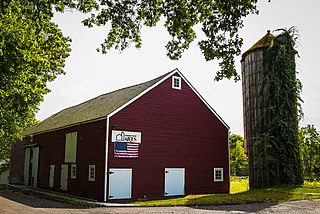
The Kennedy–Martin–Stelle Farmstead is located at 450 King George Road in Bernards Township of Somerset County, New Jersey. The 4.4-acre (1.8 ha) farmstead was added to the National Register of Historic Places on May 5, 2004 for its significance in architecture, education and politics/government from 1762 to 1852. The farmstead includes four contributing buildings and two contributing structures. It is now the home of the Farmstead Arts Center.

The Morristown District, also known as the Morristown Historic District, is a historic district in the town of Morristown in Morris County, New Jersey. It was added to the National Register of Historic Places on October 30, 1973, for its significance in architecture, communications, education, military, politics, religion, social history, and transportation.

The Hillside Avenue Historic District is a 27-acre (11 ha) historic district located along Hillside Avenue in the city of Plainfield in Union County, New Jersey. It was added to the National Register of Historic Places on June 1, 1982 for its significance in architecture, featuring Colonial Revival architecture. The district includes 33 contributing buildings.
























